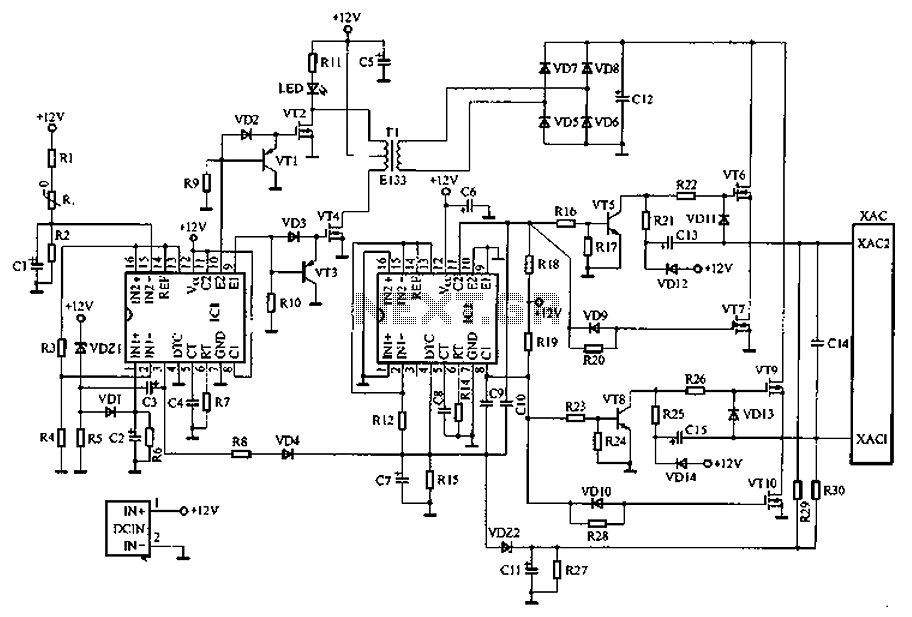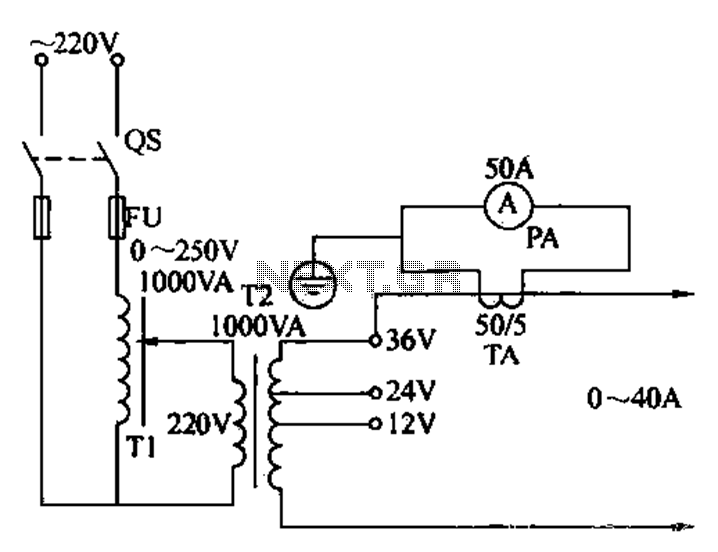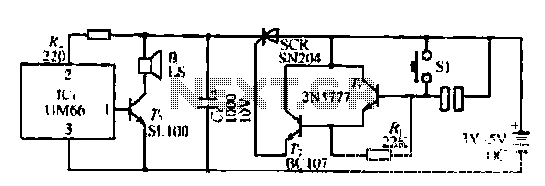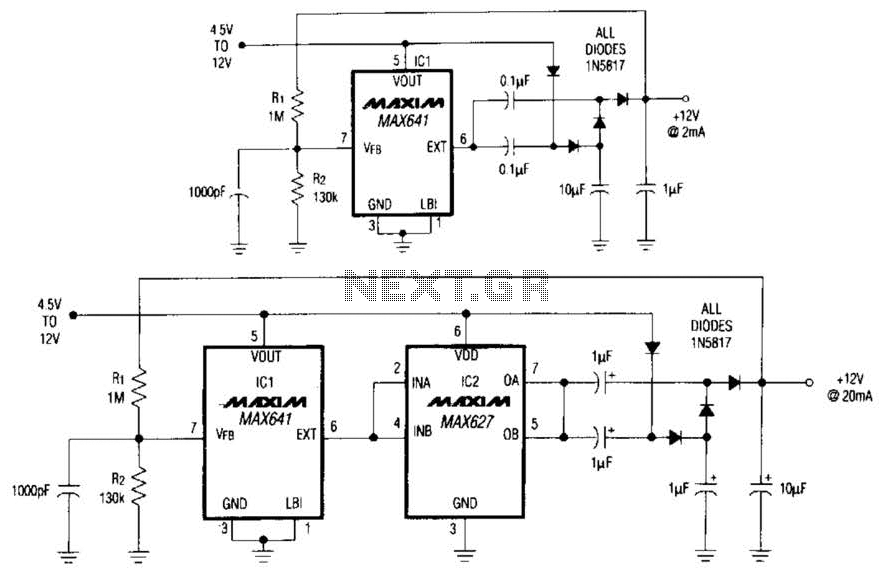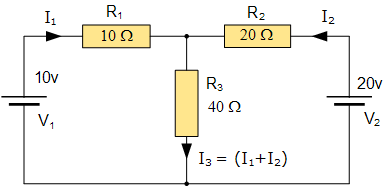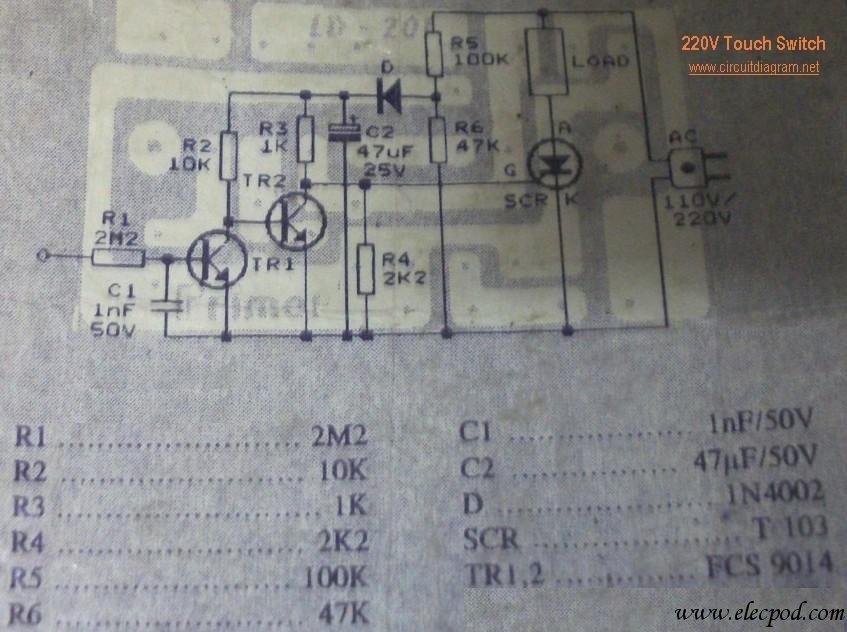
vhf video transmitter circuit

This is a simple circuit design for a video transmitter capable of radiating signals up to 50 meters. The video transmitter can be connected to a camera as a source and allows viewing on a VHF channel analog television. The power supply for the transmitter can utilize a 9V battery. The circuit employs transistor components such as the BC548, although the BF199 can also be used. Other passive components are of the SMD type. The winding coil L1 consists of 5 turns with a diameter of 8 mm, using wire with an AWG of 0.3 to 0.5 mm. Once the circuit is assembled, an antenna made from a 50 cm long cable is used. To adjust the operational frequency, a trimmer capacitor of 22 pF can be turned to match the desired frequency.
The video transmitter circuit is designed to convert video signals from a camera into a radio frequency (RF) signal that can be transmitted over a distance of up to 50 meters. The circuit's core functionality relies on the selected transistor, which amplifies the video signal for effective transmission. The BC548 transistor is a popular choice due to its general-purpose nature and suitability for low-frequency applications, while the BF199 can be used for higher frequency operations.
The circuit's power supply is straightforward, utilizing a 9V battery, which provides adequate voltage for the components involved. The use of surface-mount device (SMD) components allows for a more compact design, which is beneficial for mobile or space-constrained applications.
The coil L1 is a critical part of the circuit, consisting of 5 turns of wire with a diameter of 8 mm. The choice of wire gauge between 0.3 mm and 0.5 mm is essential, as it impacts the coil's inductance and the overall performance of the transmitter. The antenna, a simple 50 cm cable, acts as the radiating element, allowing the RF signal to propagate effectively.
To fine-tune the operational frequency of the transmitter, a trimmer capacitor of 22 pF is incorporated. Adjusting this capacitor allows the user to modify the resonant frequency of the circuit, ensuring optimal transmission on the desired VHF channel. This feature is particularly useful for avoiding interference with other signals and for compliance with local broadcasting regulations.
Overall, this video transmitter circuit is a practical solution for short-range video transmission applications, combining simplicity in design with effective performance.This is a simple design circuit for transmitter video. This circuit can radiate as far as 50m. This video transmitter can be used with the camera as a source. You can view them on VHF channel analog TV. Supply voltage to the transmitter can use 9V battery. This is the figure of the circuit. Transistor components that are used for a video transmitt er is BC548 or you can use another type of transistor BF199. Meanwhile, other passive components used SMD type. For winding coil L1 is 5 Turns 8 mm in diameter and use wire AWG 0. 3-0. 5 mm. Once you up the circuit this video transmitter, antenna use as a cable along the 50 cm. To determine the frequency of work, turn the trimmer capacitor 22 pf accordance with the frequency that you want. 🔗 External reference
The video transmitter circuit is designed to convert video signals from a camera into a radio frequency (RF) signal that can be transmitted over a distance of up to 50 meters. The circuit's core functionality relies on the selected transistor, which amplifies the video signal for effective transmission. The BC548 transistor is a popular choice due to its general-purpose nature and suitability for low-frequency applications, while the BF199 can be used for higher frequency operations.
The circuit's power supply is straightforward, utilizing a 9V battery, which provides adequate voltage for the components involved. The use of surface-mount device (SMD) components allows for a more compact design, which is beneficial for mobile or space-constrained applications.
The coil L1 is a critical part of the circuit, consisting of 5 turns of wire with a diameter of 8 mm. The choice of wire gauge between 0.3 mm and 0.5 mm is essential, as it impacts the coil's inductance and the overall performance of the transmitter. The antenna, a simple 50 cm cable, acts as the radiating element, allowing the RF signal to propagate effectively.
To fine-tune the operational frequency of the transmitter, a trimmer capacitor of 22 pF is incorporated. Adjusting this capacitor allows the user to modify the resonant frequency of the circuit, ensuring optimal transmission on the desired VHF channel. This feature is particularly useful for avoiding interference with other signals and for compliance with local broadcasting regulations.
Overall, this video transmitter circuit is a practical solution for short-range video transmission applications, combining simplicity in design with effective performance.This is a simple design circuit for transmitter video. This circuit can radiate as far as 50m. This video transmitter can be used with the camera as a source. You can view them on VHF channel analog TV. Supply voltage to the transmitter can use 9V battery. This is the figure of the circuit. Transistor components that are used for a video transmitt er is BC548 or you can use another type of transistor BF199. Meanwhile, other passive components used SMD type. For winding coil L1 is 5 Turns 8 mm in diameter and use wire AWG 0. 3-0. 5 mm. Once you up the circuit this video transmitter, antenna use as a cable along the 50 cm. To determine the frequency of work, turn the trimmer capacitor 22 pf accordance with the frequency that you want. 🔗 External reference
Warning: include(partials/cookie-banner.php): Failed to open stream: Permission denied in /var/www/html/nextgr/view-circuit.php on line 713
Warning: include(): Failed opening 'partials/cookie-banner.php' for inclusion (include_path='.:/usr/share/php') in /var/www/html/nextgr/view-circuit.php on line 713
